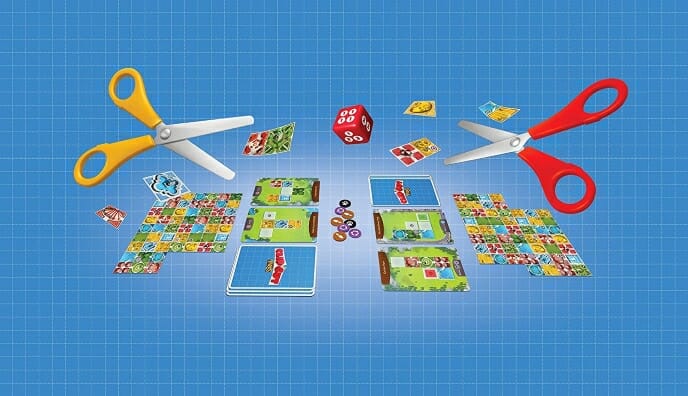ClipCut Parks Will Only Hold Your Interest If You’re Really into Scissors and Cutting Things

Silver and Gold was one of my favorite games of 2019, taking the familiar concept of Tetris-like shapes and using that to build a quick-moving game with simple scoring and a low barrier to entry for non-gamers. ClipCut Parks, one of five nominees for the Origins Award for Best Family Game this year, is a sort of kids’ version of Silver and Gold that replaces the flip-and-write mechanic—where you’d flip a card and fill in squares on your objective cards—with a “roll-and-cut” mechanic, where you roll a die and make several cuts to your giant grid of park squares, then use the pieces that fall free to cover squares on your personal cards. It’s a bit too simple for even casual adult gamers, but is great for playing with kids who love using scissors (pretty much every little kid I’ve ever met) and who are working on spatial recognition or pattern matching.
ClipCut Parks plays two to four players and gives each player five park cards at the start of the game, with each card showing some pattern of five or six squares. Some squares are blank, while some show a specific color or symbol that players must match. Each player also has a paper divided into 56 squares in four different colors, with some also showing those symbols you’ll find on park cards. On each turn, one player rolls the die, which shows one or more numbers (e.g., 1-1-2, 2-2, or just 4), and players must make distinct cuts of those lengths on their paper. So if the roll is 1-1-1-1, players must make four separate cuts, one square-side in length, on their paper. You can’t combine those to make a single cut of length 4, however. You take any pieces that fall off your main sheet and place them on your cards, if possible, to cover as much of your parks as you can. You must match colors and symbols, and can’t place pieces that don’t fit or over other pieces you’ve already placed. There are also small brown bridge symbols between some squares on park cards, showing that they can only be covered by a connected section of paper. Anything that falls off your main sheet and can’t be placed is crumpled up and set aside; it may count against you if there’s a tie at the end of the game.
